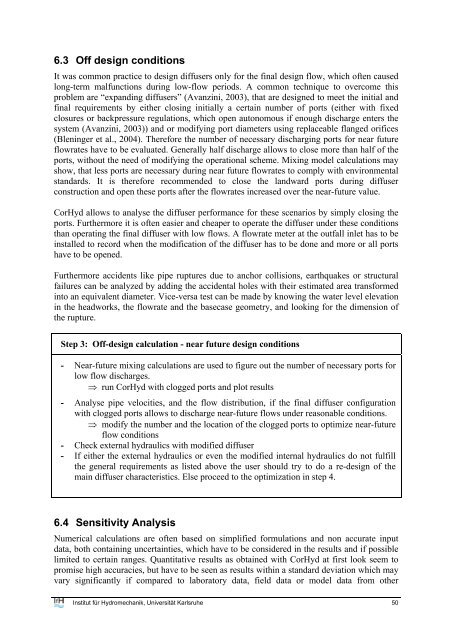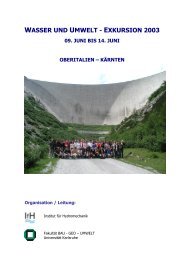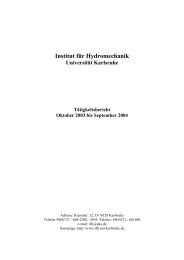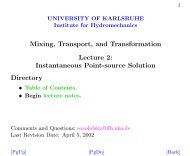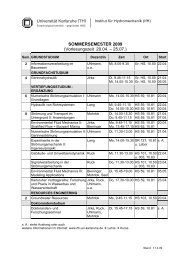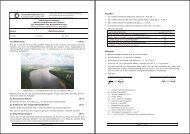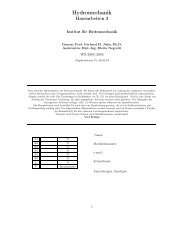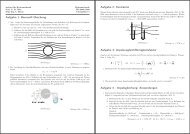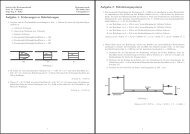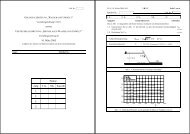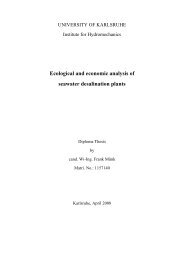user's manual for corhyd: an internal diffuser hydraulics model - IfH
user's manual for corhyd: an internal diffuser hydraulics model - IfH
user's manual for corhyd: an internal diffuser hydraulics model - IfH
Create successful ePaper yourself
Turn your PDF publications into a flip-book with our unique Google optimized e-Paper software.
6.3 Off design conditions<br />
It was common practice to design <strong>diffuser</strong>s only <strong>for</strong> the final design flow, which often caused<br />
long-term malfunctions during low-flow periods. A common technique to overcome this<br />
problem are “exp<strong>an</strong>ding <strong>diffuser</strong>s” (Av<strong>an</strong>zini, 2003), that are designed to meet the initial <strong>an</strong>d<br />
final requirements by either closing initially a certain number of ports (either with fixed<br />
closures or backpressure regulations, which open autonomous if enough discharge enters the<br />
system (Av<strong>an</strong>zini, 2003)) <strong>an</strong>d or modifying port diameters using replaceable fl<strong>an</strong>ged orifices<br />
(Bleninger et al., 2004). There<strong>for</strong>e the number of necessary discharging ports <strong>for</strong> near future<br />
flowrates have to be evaluated. Generally half discharge allows to close more th<strong>an</strong> half of the<br />
ports, without the need of modifying the operational scheme. Mixing <strong>model</strong> calculations may<br />
show, that less ports are necessary during near future flowrates to comply with environmental<br />
st<strong>an</strong>dards. It is there<strong>for</strong>e recommended to close the l<strong>an</strong>dward ports during <strong>diffuser</strong><br />
construction <strong>an</strong>d open these ports after the flowrates increased over the near-future value.<br />
CorHyd allows to <strong>an</strong>alyse the <strong>diffuser</strong> per<strong>for</strong>m<strong>an</strong>ce <strong>for</strong> these scenarios by simply closing the<br />
ports. Furthermore it is often easier <strong>an</strong>d cheaper to operate the <strong>diffuser</strong> under these conditions<br />
th<strong>an</strong> operating the final <strong>diffuser</strong> with low flows. A flowrate meter at the outfall inlet has to be<br />
installed to record when the modification of the <strong>diffuser</strong> has to be done <strong>an</strong>d more or all ports<br />
have to be opened.<br />
Furthermore accidents like pipe ruptures due to <strong>an</strong>chor collisions, earthquakes or structural<br />
failures c<strong>an</strong> be <strong>an</strong>alyzed by adding the accidental holes with their estimated area tr<strong>an</strong>s<strong>for</strong>med<br />
into <strong>an</strong> equivalent diameter. Vice-versa test c<strong>an</strong> be made by knowing the water level elevation<br />
in the headworks, the flowrate <strong>an</strong>d the basecase geometry, <strong>an</strong>d looking <strong>for</strong> the dimension of<br />
the rupture.<br />
Step 3: Off-design calculation - near future design conditions<br />
- Near-future mixing calculations are used to figure out the number of necessary ports <strong>for</strong><br />
low flow discharges.<br />
⇒ run CorHyd with clogged ports <strong>an</strong>d plot results<br />
- Analyse pipe velocities, <strong>an</strong>d the flow distribution, if the final <strong>diffuser</strong> configuration<br />
with clogged ports allows to discharge near-future flows under reasonable conditions.<br />
⇒ modify the number <strong>an</strong>d the location of the clogged ports to optimize near-future<br />
flow conditions<br />
- Check external <strong>hydraulics</strong> with modified <strong>diffuser</strong><br />
- If either the external <strong>hydraulics</strong> or even the modified <strong>internal</strong> <strong>hydraulics</strong> do not fulfill<br />
the general requirements as listed above the user should try to do a re-design of the<br />
main <strong>diffuser</strong> characteristics. Else proceed to the optimization in step 4.<br />
6.4 Sensitivity Analysis<br />
Numerical calculations are often based on simplified <strong>for</strong>mulations <strong>an</strong>d non accurate input<br />
data, both containing uncertainties, which have to be considered in the results <strong>an</strong>d if possible<br />
limited to certain r<strong>an</strong>ges. Qu<strong>an</strong>titative results as obtained with CorHyd at first look seem to<br />
promise high accuracies, but have to be seen as results within a st<strong>an</strong>dard deviation which may<br />
vary signific<strong>an</strong>tly if compared to laboratory data, field data or <strong>model</strong> data from other<br />
Institut für Hydromech<strong>an</strong>ik, Universität Karlsruhe 50


